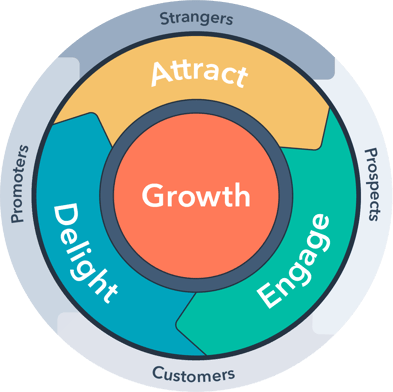Adding Value, eliminate Friction: Crafting Customer Delight
What does Client Delight look like?
Attract, Engage, Delight.
Wash, Rinse, Repeat.
Let’s be honest with ourselves: words are just words unless we know how to define and apply them, and that can be tricky, especially when it comes to the delight stage of the flywheel.
What does delight mean to clients? What is delight? And how can it be achieved within the constraints of your service level agreement (SLA) or financial barriers?
Though delight strategies like perks may look flashy and fun, they can be bad practice because it harms your bottom line and sets a precedent for future clients. Creating client delight is a process that should be considered at every flywheel stage: How will my marketing and customer service create client delight? What things can I put in place now that will be appreciated later?

Of course, there is an order when it comes to the flywheel (we need to start somewhere!), but that doesn’t mean that the other stages should be left to the last minute. Considering delight during the attraction stage will keep your flywheel spinning, and your clients won’t be able to stop talking about how amazing you are!
A Revenue Operations Approach to Delight
Imagine a Ferris wheel. The ride’s speed is regulated by the operator and how much power they give to it. If the operator applies as much force as possible, riders will have a quick nausea-inducing ride. Safe to say, most of the riders will not experience delight.
Alternatively, if the operator is engaged and paying attention to the customers, they have the opportunity to perfect the client experience to create delight. Maybe you’ve even experienced a Ferris wheel stopping when you’re at the top so that you can look around and enjoy the view.
The Ferris wheel operator stopping or slowing the ride is a simple (and extremely literal) example of applying friction during the engagement phase to create delight.

Revenue Operations (RevOps) is a system that streamlines processes to create efficiencies in your business. Streamlining processes between your sales, marketing, and customer service teams applies force to your flywheel by keeping your staff pushing towards the goal of driving revenue. Implementing a platform like HubSpot with CRM, blog, email, social media features and much more keeps your data and teams working together for the best revenue results.
This idea of friction and force is all about balance and intention. All friction and no force mean stagnant business and stalled revenue. On the other hand, a disproportionate force can cause your flywheel to spin out, pushing growth beyond your grasp. Achieving balance then requires knowing when to apply friction or force.
I know your B2B company is not as simple as a Ferris wheel, and you can’t just pump the brakes for your clients to be happy. But, slowing down and asking more questions can enhance your client experience through higher work quality by providing the right services and advice at the right time.
Crafting Customer Delight
Each business is unique as its customer. But that doesn’t mean there can’t be a process. Here are some ways to apply friction that will create client delight:
1. Ask Specific Questions
Not every customer is right for your product. Designing your marketing to attract the right customer fosters delight because you are the best fit for them. Consider what customer you are trying to attract and who you don’t want. This way, if someone stumbles onto your solution when it's not a good fit, you won’t waste your time or their time.
2. Take Your Time Creating SLAs
Clarity is key, and taking the time to be specific and clear with customers in the engagement phase will eliminate confusion. With everyone on the same page, any issues that do arise can be resolved quickly by making sure projects are delivered efficiently to keep your business healthy and growing.
3. Follow-Up Frequently
Customers want to feel prioritized and cared for, but this takes time. Broadly your business is focused on multiple customers (and of course, your clients know that) but make them feel like they're the only ones in the room. Keep in frequent contact and try to answer questions before they know that they have them. Applying friction by slowing down your processes to be diligent in communication will have your customers feeling prioritized, cared for and (most importantly) delighted.
Interested in learning more? You can always reach out and chat with us.
.png)